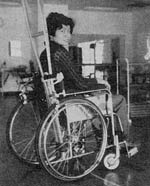Going down the wrong path
Why I openly question the "New Normal" or "New life style"
Science and Scientists
We all agree that Science, the body of knowledge that we gather using the scientific method, is one of the most valuable assets of humankind.
Yet, "Believe in the Science!" does not mean "Believe in the Scientist"! Scientists are as good and bad as the rest of humankind. Scientists make mistakes—sometimes these mistakes are very costly for the rest of society.
Sometimes, they are manipulated by powerful people and groups to do horrible things. One example that we should never forget is the involvement of many famous scientists in the Eugenics movement.
Here is another example, right from Japan, of scientists making mistakes, that for a decade and a half continued to have serious consequences for the common person.
The SMON epidemic in Japan (1958–1973)
In 1958, a frightening epidemic disease struck Japan. It was
 Michiko Kinoshita was 45 when she developed diarrhoea
in January 1966 , and was prescribed clioquinol .
Five months later, both her feet began to feel numb — one of the
first symptoms of SMON. Soon her sight failed and her legs
were paralyzed. As a result, her husband gave up his job to
look after her. Ciba-Geigy gave her an out-of-court settlement
of $184,800 in 1979 , and a monthly sum of $184 for nursing care.
Michiko Kinoshita was 45 when she developed diarrhoea
in January 1966 , and was prescribed clioquinol .
Five months later, both her feet began to feel numb — one of the
first symptoms of SMON. Soon her sight failed and her legs
were paralyzed. As a result, her husband gave up his job to
look after her. Ciba-Geigy gave her an out-of-court settlement
of $184,800 in 1979 , and a monthly sum of $184 for nursing care.
Subacute Myelo-Optico-Neuropathy (SMON) — it killed
5–10% of its victims; among those it did not kill, many
were paralyzed for life, many became blind; the rest lived with
chronic pain resulting from neurological damages.
It spared children, but the elderly were most affected, especially
those with underlying chronic illnesses. The Tokyo Olympics
arrived and passed, but still no one knew how to prevent
the spread of the epidemic or to cure it.
Scientists assumed that the disease was infectious; its sudden appearance,
 Keiko Yamaguchi was 21 years old, when she was prescribed
clioquinol for diarrhoea in February 1967 . Her SMON symptoms
started soon, and continued, and she was given more and more
clioquinol . By the end of 1968 she was completely blind
and paralyzed. In 1980 , Ciba-Geigy
paid $199,263 in compensation and $617 a month
for nursing care.
Keiko Yamaguchi was 21 years old, when she was prescribed
clioquinol for diarrhoea in February 1967 . Her SMON symptoms
started soon, and continued, and she was given more and more
clioquinol . By the end of 1968 she was completely blind
and paralyzed. In 1980 , Ciba-Geigy
paid $199,263 in compensation and $617 a month
for nursing care.
Source:
The Devil's Alternative, New Internationalist , 95, 1 January 1981
the discovery of clusters around specific cities and towns, and
clusters within families.
The disease peaked in
late summer, suggesting that the disease spread through
insects.
Further, many outbreaks
were centered around hospitals, and
medical workers had a rather high
rate of SMON.
Pages 11–27 from Prof. Peter Duesberg's Inventing the AIDS Virus
Japan launched vigourous research efforts to understand the causative agent of the epidemic. The contagion theory was strongly favoured among scientists. Over the next fifteen years, the scientists isolated 'novel' viruses one after the other, only to find their claims disproved by independent researchers . While the virus hunt went on, cases rose steadily, and so did the deaths.
Finally, in 1970, the real cause of the epidemic was found. It was the prescription drug clioquinol , a drug manufactured by Ciba-Geigy to treat diarrhea. The irony was that clioquinol itself was used as a treatment for SMON!
Further reading
A Japanese Tragedy, The Washington Post , March 18, 1979
R. Kono, 1975, The S.M.O.N. Virus Theory, Lancet , 306 , pp 370-371
The Devil's Alternative, New Internationalist , 95, 1 January 1981
The illusion that SMON was an infectious disease was compelling: When patients with abdominal upset or diarrhea were treated with clioquinol and developed SMON, family members, doctors and nurses often took the drug thinking it would protect them — inadvertently creating the very disease they feared. The resulting cluster outbreaks made SMON look like an infectious disease. In short, what people thought was a cure for SMON was in fact its cause.